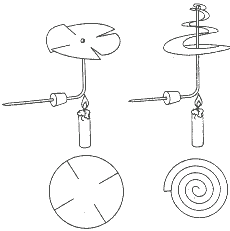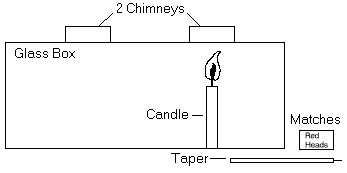
WEATHER
Convection Currents of Air
- Safety Rules:
- Parent supervision
- Take care with fire or heat
- Take care with scissors
- Materials you need are:
- a sheet of light cardboard
- scissors
- a piece of fine wire (about 50cm long)
- sticky tape
- a candle
- matches
-

Cut the paper into a spiral as in the diagram. Attach the wire to the paper so that the paper spiral can turn freely and bend it as in the diagram. Place the candle under the wire and heat it. Watch the spiral.
The paper spiral should turn due to convection currents generated by the hot air.
Make a Wind Box
- Safety Rules:
- Parent supervision
- Take care with fire or heat
- Take care with a knife
- Materials you need are:
- a large glass fish tank
- a large piece of thick cardboard
- a short candle
- matches
- a knife to cut the 2 chimneys in the cardboard
-

Set up the materials as in the diagram. Cut two holes in the lid for chimneys that have diameters of about 2 cm. Place the candle under one of the chimneys. Make sure that the candle is short enough that it will not burn the lid. Light the candle, cover the fish-tank with the lid and allow the candle to burn for a few minutes. Quickly lift the lid slightly and extinguish the flame. Don't allow the smoke to escape. Watch the movement of the smoke.
Smoke will move out of the 'hot air' chimney (hot air rises) while cooler air from outside enters through the 'cool air' chimney (cool air is heavier than hot air)to replace the hot air. This creates a wind effect.
Make a Wind Vane
- Safety Rules:
- Parent supervision
- Take care with scissors
- Materials you need are:
- a piece of thick cardboard
- scissors
- cotton thread
- a sewing pin
- sticky tape
- paperclips
-

Cut out the arrow shape as in the diagram. Attach some paperclips to the front end of the arrow to weigh it down. Find the balance point by sticking a pin in until the arrow hangs horizontally and tie on the piece of cotton thread at this point. Hang it up where the wind blows and it point the wind direction. Try different long thin shapes.
Make an Anemometer (Wind Speed Indicator)
- Safety Rules:
- Parent supervision
- Take care with a knife and a hammer
- Take care with glue (It is poisonous)
- Materials you need are:
- a supporting pole
- a headless nail
- 2 pieces of light wood (about 50cm X 2.5cm X 0.5cm)with a hole in the
- middle of each
- a pointed pen top
- 4 plastic drinking cups (one must be a different colour to the others)
- some quick-drying glue
- 4 nuts and bolts
- a hammer
- a spanner
-

Use the diagram. Hammer the nail head first into the supporting pole. Push the pen top through the central hole in each wooden piece and glue the pieces at right angles to form a cross. Use nuts and bolts to fasten a cup to the end of each wooden piece.Push the pole into the ground so it stands upright. Rest the pen top on the nail. Use plasticine if your anemometer needs balancing. Wait for some wind and watch your anemometer revolve.
Fog in a Bottle
- Safety rules:
- Parent supervision
- Take care with hot water
- Materials you need are:
- a large clear jar
- hot water
- a strainer (or plastic wrap)
- ice cubes
Fill the bottle with hot water and cover it to warm it. Leave for 10 minutes. Pour out all except about 3 cm of water. Put a strainer over the opening. Place ice cubes in the strainer and watch.
The colder ice cubes should cause the original warm water vapour to condense into fog.